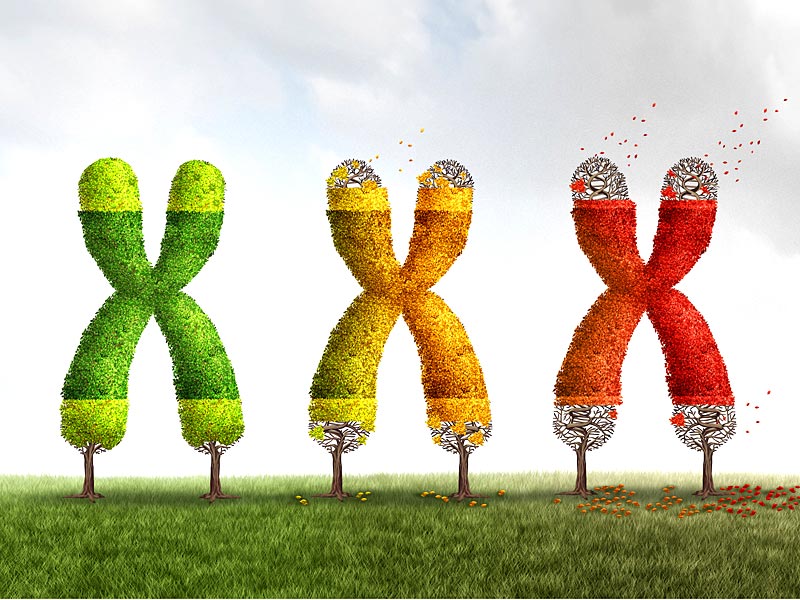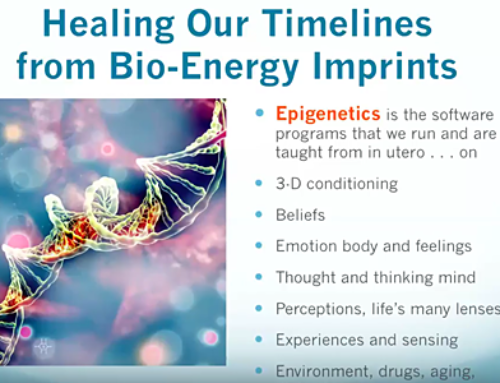How fast we age and how long we maintain brilliant health and ageless vitality is in our hands. In an ideal state, the human body is designed to live for hundreds, if not thousands, of years. And discoveries about the body’s telomeres are providing us with a key to moving in this direction.
Understanding telomeres will unlock many answers to questions about biological aging, health, longevity, and managing age and age-related disease.
What Are Telomeres?
 In the human body, cell division is necessary for growing new skin, blood, bone, and other cells—it’s the body’s regenerative process for sustaining life. When our cells divide, we pass on genetic data to the replicating cell via chromosomes.
In the human body, cell division is necessary for growing new skin, blood, bone, and other cells—it’s the body’s regenerative process for sustaining life. When our cells divide, we pass on genetic data to the replicating cell via chromosomes.
Telomeres are the caps at the end of each strand of DNA that protect our chromosomes, like the plastic tips at the end of shoelaces.
Telomeres keep chromosome ends from fraying and sticking to each other and destroying genetic information essential to a healthy lifespan.
During the normal human lifespan, a cell divides on average about 50 to 70 times. Each time a cell divides, its telomeres get shorter—even on healthy cells: they are our internal biological clock. When the telomeres get too short, the cell can no longer replicate and divide; it becomes inactive or “senescent,” deteriorating with age. This shortening process is associated with aging, disease, and a higher risk of death.
Telomeres: Master Timekeeper
 Telomeres are a measurement of our future health. They are the keepers of our biological age and our risk for disease. They are the governing factor in how fast we age, how long we may live, and how we can maintain health for life.
Telomeres are a measurement of our future health. They are the keepers of our biological age and our risk for disease. They are the governing factor in how fast we age, how long we may live, and how we can maintain health for life.
Short telomeres can be predictive of your risk for multiple age-related diseases, like cancer, diabetes, dementia, Alzheimer’s, heart disease, atrophy of brain cells, and more.
Unhealthy cells, like cancer cells, also have telomeres. When the cell mutates due to lack of nutrients and oxygen, the telomeres mutate too. The cells divide, and their telomeres become shorter with each division or replication; thus, mutated telomeres shorten much faster than healthy ones do, causing a progressive degenerative condition in the body.
Long telomeres allow the body’s regenerative force to be preserved for the continual production of healthy new brain cells, blood, tissues, skin, hair, etc.
People with long telomeres feel and act youthful, look younger, and have a greater resistance to getting sick or developing diseases. They age much slower and have an enhanced capacity for long life.
What Affects Telomere Length—and Your Future State of Health?
 Many influences affect the length of telomeres, and thus, the future state of your health. One of the main factors governing telomeres is the expression of a gene called TERT. Short telomeres often are an indication that the TERT gene is locked, non-active, or minimally expressed. With the completion of the human genome mapping, we can now benefit from this scientific discovery, offering a natural remedy to enhance telomere health and longevity (Telomerase, described below).
Many influences affect the length of telomeres, and thus, the future state of your health. One of the main factors governing telomeres is the expression of a gene called TERT. Short telomeres often are an indication that the TERT gene is locked, non-active, or minimally expressed. With the completion of the human genome mapping, we can now benefit from this scientific discovery, offering a natural remedy to enhance telomere health and longevity (Telomerase, described below).
Another critical factor affecting health is oxidative stress, i.e., free-radical damage to our DNA. Nrf2, a cell regulator (see article “Turning Back Your Biological Clock”), is of primary importance in managing free-radical damage due to oxidation.
Still other factors include homocysteine levels (see discussion and remedy below), inflammation, Vitamin D (see remedy below), weight, heavy metals, diet, stress, and environment.
Natural Bio-Light Solutions for Telomere Health & Longevity
Bio-Light Solutions is a comprehensive line of natural formulas found to enhance the expression of many genes. Examples of genes that have been scientifically found to promote wellness include the following:
TERT—Preserving Your Genetic Information
Telomeres utilize a protein called telomerase to prevent chromosomes from growing shorter during replication and losing our genetic data. Telomerase contains an enzyme called TERT, which replenishes and supports synthesis of telomeres by elongating the telomeres; if telomerase is activated in a cell, the cell will continue to grow and divide. This “immortal cell” theory is important in two areas of research: aging and cancer.
The TERT gene supports new tissue growth and slows the aging process. Each time a cell divides, whether to repair damaged tissue, renew old tissues, or during development, the ends of the cell’s chromosomes become frayed or lost. When too many of the chromosome ends are lost, the cell loses the ability to divide and form new cells. This is called cellular senescence, and it results in tissue aging.
TERT gene expression helps to repair the ends of damaged chromosomes so that new cells and new tissues can be produced, slowing down the aging process and repairing damaged tissues more effectively.
NOTE: Enhancing the TERT gene is not recommended for those suffering from cancer. Extensive research continues in this area.
MTHFR—Supporting Methylation and Your Genetic Blueprint
MTHFR plays an important role in the conversion of amino acid homocysteine back to another amino acid, methionine—a process called methelation. Methionine is an essential amino acid that plays a very important role in making sure that genes work properly; it can be used to support the function of the genetic blueprint.
Homocysteine is an amino acid that inflicts damage to the inner arterial lining (endothelium) and other cells of the body. High levels of homocysteine have been found to cause many diseases, both psychological and physical, such as heart disease, migraine, stroke, hearing loss, and blood vessel deterioration. Scientists have shown that there is an increase in the serum concentration of homocysteine with age and that this increase is associated with increased susceptibility to many diseases, including heart disease.
Decreased activity of MTHFR leads to inefficient conversion of homocysteine to methionine. Methionine is used by your body to make proteins, utilize antioxidants, and assist your liver to process fats. Methionine helps with depression and even inflammation. It is involved with the growth repair and maintenance of your cells. It supports your immune system and helps with the production and utilization of your brain chemicals serotonin, dopamine, and melatonin. Proper methylation means you will have a greater chance of eliminating toxins and heavy metals.
CYP27A1—Your Vitamin D Gene
This gene plays a critical role in the natural synthesis of vitamin D. Most tissues and cells in the body have a vitamin D receptor (VDR) and vitamin D influences the expression levels of up to one-third of all human genes.
Many studies have indicated an association of vitamin D deficiency with increased risk of development of more than a dozen cancers, autoimmune diseases, type 1 and type 2 diabetes, rheumatoid arthritis, Crohn’s disease, multiple sclerosis, infectious diseases, and cardiovascular disease.
Because CYP27A1 plays such an important role in synthesizing the active form of vitamin D, the importance of this enzyme in maintaining optimum health is critical. This was underscored by the fact that TIME magazine nominated vitamin D as one of the “top medical breakthroughs” in the December issue of 2007.
Unless the CYP27A1 gene is turned on, no amount of Vitamin D will be assimilated by the body.
Longevity Genes
The KL, GH1, and IL-7 help everyone to slow down the aging process and live a longer, healthier life.
The KL gene, which synthesizes the hormone Klotho, plays a very important role in slowing down the aging process. Scientists have shown that reduced activity of KL results in acceleration of the aging of many organs, and in particular, leads to skin deterioration. Reduced KL activity is associated with impaired immunity and increased susceptibility to development of autoimmunity.
IL-7 stimulates the production of new immune cells in the bone marrow.
GH1 helps to reduce muscle loss, a component of aging, and build up muscle by stimulating cells that form new muscle. It also enhances new muscle growth by increasing amino acid uptake in newly forming muscle cells, as well as other tissues.
HSF1—Coordinator of the Body’s Protein Repair System
HSF1 is known to be a master regulator gene to repair damaged proteins that cause ill health.
Almost a million proteins are required to organize and carry out all the physiological and psychological functions needed to maintain optimum health throughout life. For a protein to work effectively, it must have the correct fit with its receptor, rather like a lock and key fitting system.
However, the correct structure of many proteins is often difficult to maintain because their structure is altered by exposure to many factors, such as increased temperature, toxins, radiation from all sources (including sun exposure, electromagnetic radiation, infectious agents, etc.), and more.
The HSF1 gene coordinates the body’s entire protein repair system. In this way, disfigured, dysfunctional proteins can be refolded and repaired so that they can function at full capacity.
Note: Not recommended for use in cancer patients because it is likely to protect cancer cells from the cytotoxic effects of radiotherapy and chemotherapy.
ELN—Maintaining Skin and Tissue Plasticity
The ELN gene synthesizes elastin, the most important protein to keep skin, lungs, and arteries pliable, slowing down skin aging and wrinkling and maintaining plasticity of arteries and lungs. Elastin is an essential component of various human tissues, including the skin, lungs, and arteries. Elastin provides these elastic tissues with the ability to stretch and recoil as required. Elastin decreases with age, and by middle age only very small amounts are produced by the body.
As production of elastin deteriorates, tissue plasticity declines, signaling the onset of aging of the skin and dysfunction of the lungs and arteries.
To schedule a consultation, contact Lilli.
Copyright © Dr Lilli Botchis






